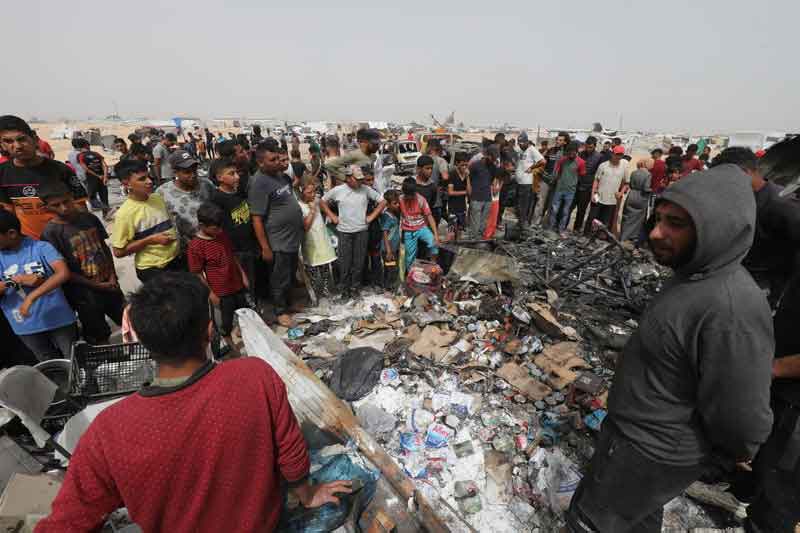
It was much like witnessing a boy killing flies, with a slight afterthought of apology. The spokesman for the Israeli Defense Forces, Rear Admiral Daniel Hagari, did little to acquit himself, or the cause, as to why more Palestinian civilians had been indulgently killed in yet another Israeli air strike. “Despite our efforts to minimize civilian casualties during the strike, the fire that broke out was unexpected and unintended … Our investigation seeks to determine what may have caused such a large fire to ignite.”
The release commences with the usual garnish. The strike, despite resulting in deaths in a camp of displaced Palestinians in Tal al-Sultan, was soberly designated and professionally targeted. It was successful. Two Hamas terrorists had been procedurally “eliminated” (in the social media release, the IDF proudly places the word upon the heads of Yassin Rabia and Khaled Nagar). “The strike was based on precise intelligence,” Hagari tells us. Those killed had, in turn, killed Israelis. They were having a meeting. “Their deaths saved lives.”
Away from the glove handling reflections of Hagari, the returns of the May 26 strike showed that Palestinian civilians were also seen as miscellaneous detritus, fundamentally dispensable. The butchery is now a matter of record: 46 dead civilians, including 23 women, children and the elderly. All on a sliver of territory fast becoming the most famous real estate of death on the planet. It’s a particularly bloody ratio for killing two alleged terrorists.
In a statement on May 29 from the UN Office of the High Commissioner for Human Rights, various rapporteurs, including such figures as Francesca Albanese, responsible for the situation of human rights in the Palestinian territories occupied since 1967, to Ben Saul, charged with the task of promoting human rights and fundamental freedoms while countering terrorism, expressed their dismay. “Harrowing images of destruction, displacement and death have emerged from Rafah, including infants torn apart and people burnt alive.” Such reports indicated “that the strikes were indiscriminate and disproportionate, with people trapped inside burning plastic tents, leading to a horrific casualty toll.”
The Israelis have been told by a number of international bodies, entities, and sympathisers, with repeated urgency, that its current murderous efforts are simply not worth it. The Rafah front presents further calamitous risks. The toll, notably in striking camps of civilians displaced by prior bombings and military engagements, would be too great. The reputational toll, likewise. The slaughter that pads out and packs morgues; the bodies of women and children that seem to multiply with pestilential cruelty; the incidents of pure callousness dressed in a décor of euphemism: We target, and we target well; the rest is accidental or unavoidable.
The International Court of Justice, in yet another ruling on Israel’s campaign in Gaza, recently concluded that the military offensive in Rafah, along with “any other action in the Rafah governorate, which may inflict on the Palestinian group in Gaza conditions of life that could bring about its physical destruction in whole or in part” be “immediately” halted. It also ordered Israel to open the Rafah crossing and permit UN officials to enter Gaza and report back to the court within a month to verify compliance.
The ICJ also noted the concerns of UN officials about the risks arising from any military assault on Rafah, one that would put “hundreds of thousands of people … at imminent risk of death”. Such risks had already “started to materialize and will intensify even further if the operation continues”.
Israel’s politicians and military personnel – at least those lacking candour – always hit upon the same formula in such instances. It is one noted by such unflagging scribes as the late Robert Fisk: the justification of violence with seemingly sound process, decency with the stuffing of crime. A trained pupil in such efforts is Israeli Prime Minister Benjamin Netanyahu. “Despite our utmost efforts not to harm innocent civilians, last night, there was a tragic mistake.” When compared with his previous statements equating all Palestinians to actors behind a terrorist cause, one that would, in turn, give birth to a terrorist state, the element of mistake is less relevant than the desire to conclude the task at hand.
The next instalment of the performance involves the mandatory investigation that yields no culprits, no charges, and no prosecutions. “The details of the incident are still under investigation, which we are committed to conducting to the fullest extent,” gabbled Major-General Yifat Tomer-Yerushalmi at a news conference, noting that the IDF “regrets any harm to non-combatants during the war.”
Such a method is also approved by Israel’s staunchest ally. “You cannot reach a conclusion about the results of these investigations in the middle of a conflict,” reasonedWhite House spokesman John Kirby. Why, it should be asked, bother?
The Israeli response to attacks on its citizens on October 7 last year, increasingly enfeebled by reality, long ago moved into the realm of farce. But farce and advertising tend to be part of the same show, and the advertising about the ongoing campaign in Gaza by the Israeli forces continues to rattle the swill bucket.
Dr. Binoy Kampmark was a Commonwealth Scholar at Selwyn College, Cambridge. He currently lectures at RMIT University. Email: bkampmark@gmail.com